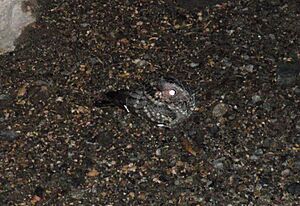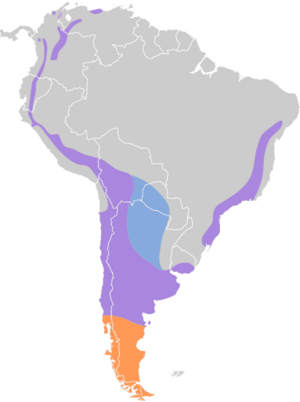Band-winged nightjar facts for kids
Quick facts for kids Band-winged nightjar |
|
|---|---|
 |
|
 |
|
| Conservation status | |
| Scientific classification | |
| Genus: |
Systellura
|
| Species: |
longirostris
|
| Subspecies | |
|
See text |
|
 |
|
The band-winged nightjar or greater band-winged nightjar (Systellura longirostris) is a cool bird from the nightjar family. It lives all over South America, especially in places like the Andes mountains, Chile, Argentina, and Brazil. You can find it in many different spots, from humid forests to dry, shrubby areas, and even on city rooftops!
Contents
Bird Families and Subspecies
Scientists group these birds based on how they look. Some band-winged nightjars are more greyish-brown, usually found in lower, eastern, and southern areas. Others are blackish-brown, living in northern and western mountain regions. Both types can have different colors, and males and females often look a bit different from each other.
Different Types of Band-winged Nightjars
There are eight known types, or subspecies, of the band-winged nightjar. Two of these were only recently discovered in Chile and Brazil! Another bird, Tschudi's nightjar, used to be considered a type of band-winged nightjar, but now scientists say it's its own separate species.
Here are the different subspecies and where they live:
- S. l. ruficervix – Found in Colombia, Venezuela, and Ecuador.
- S. l. roraimae – Lives in the tepuis (table-top mountains) of southern Venezuela.
- S. l. atripunctata – From Peru to northwestern Argentina.
- S. l. bifasciata – Found in Chile and western Argentina.
- S. l. pedrolimai – Lives in northeastern Brazil.
- S. l. longirostris – Found in southeastern Brazil, Paraguay, Uruguay, and northeastern Argentina.
- S. l. mochaensis – Lives in central Chile.
- S. l. patagonica – Found in central and southern Argentina.
What They Look Like
The band-winged nightjar has a special white band on its wing that you can easily see when it flies. In males, this band is white, and in females, it's more buff-colored.
These birds are about 20 to 27 centimeters (8 to 11 inches) long. Their eyes, beak, legs, and feet are usually brown or blackish-brown. Their body feathers can be greyish-brown, blackish-brown, brownish-orange, or yellowish-brown. The back of their neck might be brownish-orange or yellowish-brown.
Males often have white marks on their lower throat and tail feathers. Females usually have a yellowish-brown throat and no white marks on their tail. Young birds look similar to adults but have fewer spots and a smaller brownish-orange band on their wing feathers.
Baby Nightjars
When baby nightjars hatch, they have special fluffy feathers that help them blend in with the ground. This keeps them safe from predators. It takes about eight days for their feathers to start looking like the adults'. They hatch with their eyes partly open and stay very still on their first day. They start taking short flights after about 12 days, with an adult watching over them.
What They Sound Like
Band-winged nightjars make different sounds. Their main call, which they use to mark their territory, is a high, sharp whistle that sounds like seeeeert sweeeert seeeet. They repeat this every 1 to 3 seconds, especially at dusk or dawn. When they fly during breeding season, they might make a high cheet sound. Females sometimes make a nasal sound like tchree-ee if they are startled and fly away.
Where They Live and Their Home
The band-winged nightjar is a South American bird that can live very high up, even at 4200 meters (about 13,800 feet) in the mountains! Their homes can be anywhere from the edge of a forest to dry, open areas, and even on the roofs of buildings. They are mostly active at night.
They rest during the day in many different places, like on the forest floor or on buildings. In the city of Rio de Janeiro, Brazil, these nightjars have learned to rest near lights. This is because the lights attract insects, which makes it easier for the birds to find food!
How They Live
What They Eat
Band-winged nightjars love to eat insects. Their favorite foods include moths, beetles, and termites.
How They Raise Their Young
The time of year when band-winged nightjars breed changes depending on where they live. For example, in western Venezuela, it's from February to September, while in Argentina and southeastern Brazil, it's from September to October.
These birds don't build a fancy nest. Instead, they lay their eggs right on the ground in a small dip. This could be in thick plants, on bare ground, or even by the side of a road. They usually lay 1 or 2 eggs each breeding season. The eggs are oval-shaped and can be creamy pink, whitish, or spotted with brown, lilac, and grey.
The eggs hatch after about 17 days. Female nightjars spend a lot of time (around 14 hours a day) sitting on the eggs, while males usually spend about 20% of their time helping. The parents typically leave the nest during dusk or dawn.


